The global ashwagandha extract market was valued at $864.3 million in 2021, and is projected to reach $2.5 billion by 2031, growing at a CAGR of 11.4% from 2022 to 2031.
Withania somnifera, often known as ashwagandha, is a common plant used in Ayurvedic treatment. It is a tiny shrub that is a member of the Solanaceae family. It could be beneficial for a variety of illnesses, mostly as a nervine tonic (has a soothing effect on nerves). Ashwagandha is also known as Indian winter cherry or Indian ginseng. The rasayana (tonic) virtue of ashwagandha is well recognized. Rasayana is an herbal or metallic concoction that promotes happiness and a youthful state of physical and mental health.
Similar to the medication lorazepam, ashwagandha may have anxiolytic (anxiety-relieving) effects. In addition, ashwagandha might have potential as an antidepressant. This suggests that ashwagandha may aid in the treatment of anxiety and depression. It is possible that ashwagandha possesses anti-arthritic qualities that are generally acknowledged and published. Ashwagandha's ability to calm the nervous system may assist it to reduce pain. Patients in a test study received an ashwagandha-containing formula. This herbal remedy appeared to have the ability to lessen the severity of pain and impairment. Thus, owing to above medicinal benefits of the ashwagandha, it has been gaining considerable traction in pharmaceutical industry.
Rise in demand for natural functional food and drinks and rise in inclination of the people toward healthy lifestyle and rise in spending on healthy and fortified food is likely to boost the ashwagandha extract market demand during the forecast period. Ashwagandha has a number of health advantages as it lowers cholesterol levels, boosts male fertility, eases anxiety and stress, fights diabetes, controls hair loss, slows the progression of osteoporosis and rheumatoid arthritis, treats cancer, stimulates the thyroid gland, lessens eye diseases, has anti-tumor, anti-inflammatory, and antibacterial properties. Thus, above mentioned factors are likley to supplement the growth of the ashwagandha extract market size during the forecast period.
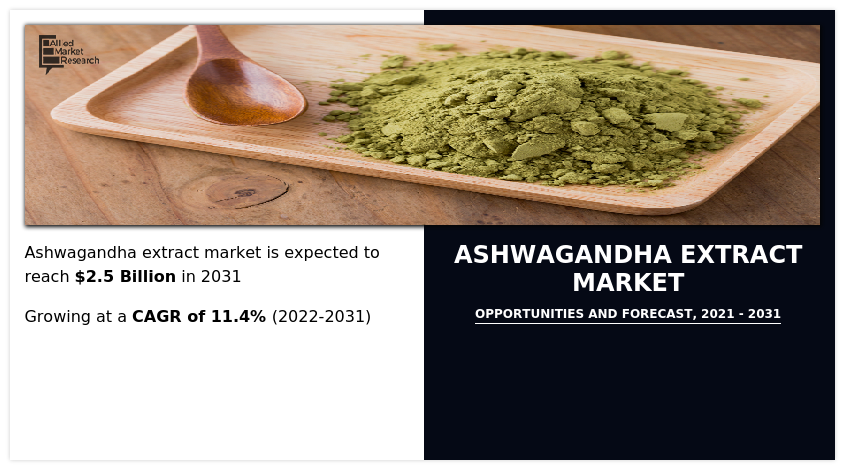
According to the ashwagandha extract market analysis, the ashwagandha extract market is segmented into form, application, distribution channel and region. On the basis of form, the market is categorized into powder, capsules/tablets and others. By application, it is segmented into sports nutrition, food and beverages, dietary supplements and others. By distribution channel, it is segregated into business to business and business to consumer. On the basis of region, it is analyzed across North America (the U.S., Canada, and Mexico), Europe (Germany, France, UK, Spain, Italy, Russia and Rest of Europe), Asia-Pacific (China, Japan, India, Australia and New Zealand, South Korea and Rest of Asia-Pacific), and LAMEA (Brazil, South Africa, Saudi Arabia, Turkey and Rest of LAMEA).
According to the ashwagandha extract market analysis, on the basis of form, powder segment was the highest contributor to the market and is estimated to reach $841.4 million by 2031, at a CAGR of 12.6% during the forecast period. Ashwagandha extract is available in powder form in the market. When combined with ghee, honey, or water, powdered ashwagandha root is traditionally consumed or administered topically to sore joints or as part of an ayurvedic skincare regimen. There has been an increase in the usage of ashwagandha extract powder in the food and beverage, pharmaceutical, and other industries as well as in sports nutrition. This is explained by the fact that ashwagandha powder has a lengthy shelf life and is naturally extremely soluble. As a result, ashwagandha producers are planning to increase the amount of ashwagandha they produce in powder form. As a result, the market for ashwagandha extract in powder form is expanding.
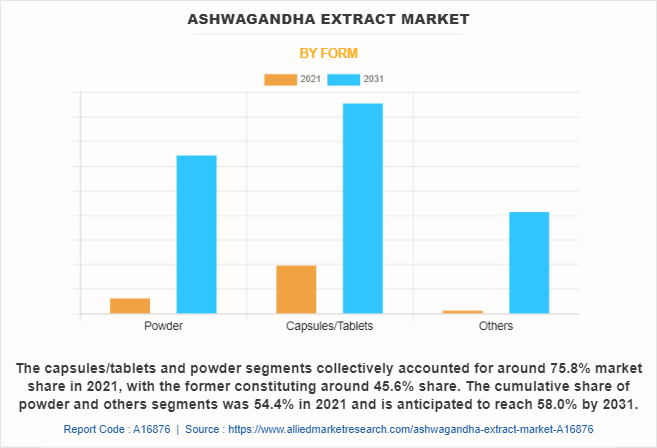
According to the ashwagandha extract market trends, on the basis of application, the dietary supplement segment was the highest contributor to the market, with $335.7 million in 2021, and is estimated to reach $1,006.1 million by 2031, at a CAGR of 11.7% during the forecast period. Rise in demand for dietary supplement and increase in awareness regarding nutritional and medical benefits of ashwagandha are expected to support ashwagandha extract market growth through dietary supplement. The increase in consumer awareness regarding personal health and wellbeing is expected to be a key factor driving the market growth for dietary supplements during the forecast period. The working population around the globe is struggling to fulfill the daily nutrient requirements owing to hectic work schedules and changing lifestyles. This is increasing their dependency on dietary supplements to fulfill the nutrient requirements owing to high convenience, which, in turn, is expected to drive the market growth during the forecast period. The elderly population is focusing on adapting nutritional supplements specifically tailored to their needs to maintain their good health and quality of life. Thus, above factors are likely to boost the growth of the ashwagandha extract industry through dietary supplement market during the forecast period.
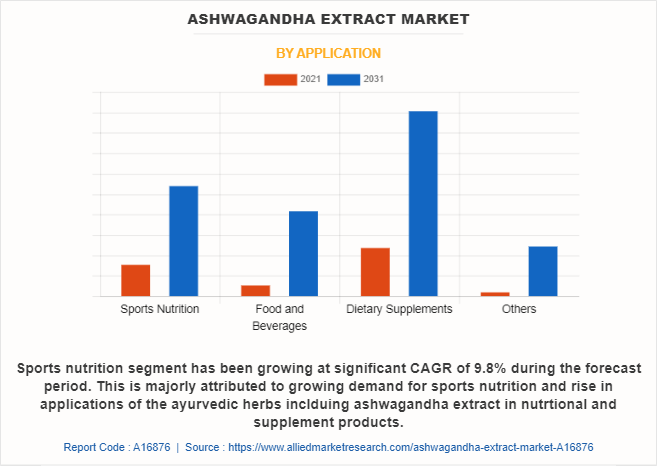
According to distribution channel, the business to consumer segment was the significant contributor to the market, with $565.7 million in 2021 and is expected grow at a CAGR of 11.1% during the forecast period. Urban and semi urban population prefer outlets, specialty store, and hypermarket/supermarket due to easy accessibility of products. It has been seen that increase in the number of stores with major players such as Ayurvedic stores, are becoming one of the trends in the ashwagandha extract market. This store offers varieties of products based on consumer preference and convenience is one of the growth factors in this sub-segment. Furthermore, these retail stores offer variety of brands in a particular product form, offering more options for consumers to buy ashwagandha extract products of their choice. Thus, these factors collectively contribute to the growth of the overall ashwagandha extract market size.
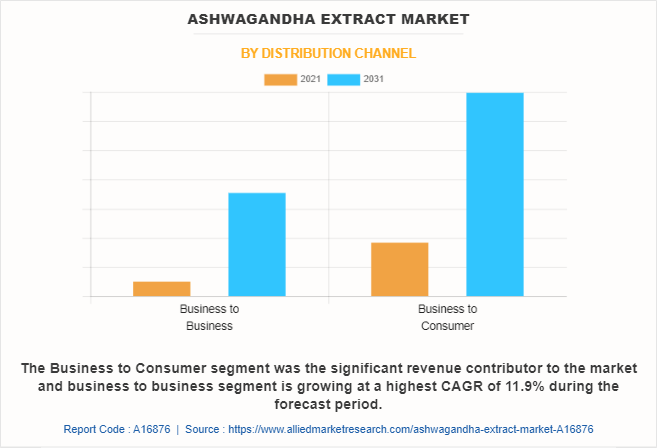
According to the ashwagandha extract market opportunity, region wise, North America garnered the major ashwagandha extract market share in 2021, and is expected to maintain its market share throughout ashwagandha extract market forecast period. North America witnessed a significant growth rate in 2021 due to extensive awareness about using ayurvedic herbs medicines including ashwagandha extract and acceptance by the large population in the region. People are beginning to discover ayurveda as a sister science of yoga. Increasing consumer awareness and growing demand for ayurvedic medicines products in the region is expected to gain a major traction in the market. Furthermore, growing demand for sports nutrition and dietary supplement in the U.S. is likely to boost the growth of the North America ashwagandha extract market during the forecast period.
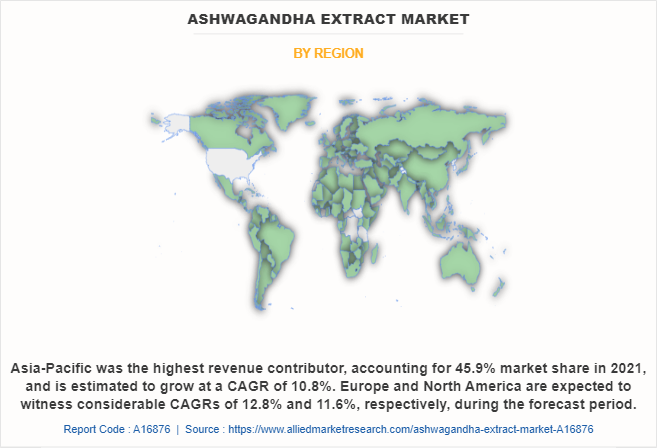
The players operating in the global ashwagandha extract industry have adopted various developmental strategies to expand their market share, increase profitability, and remain competitive in the market. The key players profiled in this report The Himalaya Drug Company, Dabur India Ltd., Emami Limited, Kairali Ayurvedic Group, P&G, Patanjali Ayurved Limited, Kerry Group PLC, Shree Baidyanath Ayurveda Bhawan Pvt. Ltd., Taos Herb Company and Unilever PLC.
Key Benefits For Stakeholders
- This report provides a quantitative analysis of the market segments, current trends, estimations, and dynamics of the ashwagandha extract market analysis from 2021 to 2031 to identify the prevailing ashwagandha extract market opportunities.
- The market research is offered along with information related to key drivers, restraints, and opportunities.
- Porter's five forces analysis highlights the potency of buyers and suppliers to enable stakeholders make profit-oriented business decisions and strengthen their supplier-buyer network.
- In-depth analysis of the ashwagandha extract market segmentation assists to determine the prevailing market opportunities.
- Major countries in each region are mapped according to their revenue contribution to the global market.
- Market player positioning facilitates benchmarking and provides a clear understanding of the present position of the market players.
- The report includes the analysis of the regional as well as global ashwagandha extract market trends, key players, market segments, application areas, and market growth strategies.
Ashwagandha Extract Market Report Highlights
| Aspects | Details |
| Market Size By 2031 | USD 2.5 billion |
| Growth Rate | CAGR of 11.4% |
| Forecast period | 2021 - 2031 |
| Report Pages | 256 |
| By Application |
|
| By Distribution Channel |
|
| By Form |
|
| By Region |
|
| Key Market Players | Taos Herb, Kerry Group plc, The Procter & Gamble Company, shree baidyanath ayurveda bhawan pvt.ltd, Patanjali Ayurved Limited, Unilever plc, The Himalaya Drug Company., Dabur India Ltd, kairali ayurvedic group, Emami Limited |
Analyst Review
Top CXOs believe that research and development is essential for the ashwagadha extract market to expand in terms of value sales. Increase in consumer demand for different dietary supplement and functional food has given producers the opportunity to create herbal or organic ashwagandha extract with reasonable prices and eco-friendly packaging. According to CXOs, rise in health awareness and customer inclination toward healthy lifestyle, and increasing demand for sports nutrition products are likely to boost the demand for ashwagandha extract. Within the Asia-Pacific region, India has attained global prominence for its wide Ayurvedic herbs product range including ashwagandha extract, thereby becoming a preferred destination for medical tourism. Ashwagandha is a well-known adaptogen that is prized for its capacity to boost vitality, energy, endurance, and stamina, which raises the possibility that it could improve athletic performance. Millions of people have used the Ayurvedic herb ashwagandha for millennia as a traditional treatment for general weakness and to increase vigor and stamina. According to the study's findings, healthy, active adults' cardiorespiratory endurance and quality of life are both improved by ashwagandha (as KSM-66). For treating male sexual dysfunction and infertility, ashwagandha (Withania somnifera Dunal) has long been prescribed in Ayurvedic therapy. Studies have demonstrated that it can raise testosterone levels in people. Thus, growing infertility in male and female due to increase in stress, depression, hectic lifestyle, unhealthy food consumption are likely to surge the demand for ashwagandha extract.
The global ashwagandha extract market was valued at $864.3 million in 2021, and is projected to reach $2.5 billion by 2031
The global Ashwagandha Extract market is projected to grow at a compound annual growth rate of 11.4% from 2022 to 2031 $2.5 billion by 2031
The Himalaya Drug Company., shree baidyanath ayurveda bhawan pvt.ltd, Unilever plc, Patanjali Ayurved Limited, kairali ayurvedic group, Kerry Group plc, The Procter & Gamble Company, Dabur India Ltd, Taos Herb, Emami Limited
North America garnered the major ashwagandha extract market share in 2021
Increase in demand for natural functional food and drinks Inclination of the people toward healthy lifestyle and rise in spending on healthy and fortified food
Loading Table Of Content...
Loading Research Methodology...



